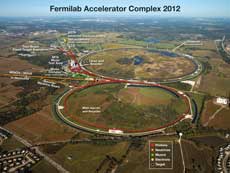Proton beam upgrade team springs into action this week
 |
| This Fermilab Accelerator Complex Illustration shows the upgrade plan. Photo: Reidar Hahn
|
Technicians and engineers have a lot of work ahead as the beam line and accelerator complex is revamped to sustain a faster-pulsed, more intense proton beam. The 11-month long shutdown of the beam line for upgrades begins today.
“This is going to be the most work done on the beam line and its supporting infrastructure since the Main Injector was constructed in the mid-1990s,” said Cons Gattuso, who is responsible for coordinating the upgrades during the shutdown. “We have a lot of work to do, and we’re eager to get started.”
The upgrades will prepare the beam line for the NOvA experiment, as well as experiments such as Mu2e and Muon g-2, which require more protons than the accelerator complex and beamline were originally configured to create and sustain.
“Several components of the accelerator complex, such as the Linac and Booster, are about 40 years old,” said Bob Zwaska, the deputy project leader for the Proton Improvement Plan, which is initiating upgrades to the Linac, Booster and preaccelerator during the shutdown. “We need to ensure that these components can sustain the higher demand for beam that will come when NOvA, Mu2e and g-2 become operational.”
In order to meet the increasing demand for protons, Gattuso and a team of technicians are reconfiguring the Recycler to process the protons into ready-to-accelerate batches before they are delivered to the Main Injector. This will increase the number of protons in each batch by approximately 10 percent and trim the time between proton pulses from 1 pulse every 2.3 seconds to 1 pulse every 1.3 seconds.
“In the current setup, the Main Injector accumulates the protons, bunches them and ramps up their energy,” Gattuso said. “In the new setup, all the accumulating, batching and processing will occur in the Recycler, which will then deliver the ready-to-go protons packets to the Main Injector. Metaphorically speaking, it’s like switching from retail to wholesale—we’re outsourcing the boxing and packaging work to the Recycler so that we can more efficiently disseminate the prepacked protons from the Main Injector to the rest of the accelerator complex.”
Historically, the Recycler accumulated and stored antiprotons before they were transferred into the Main Injector. This new configuration will require upgrades to not only the Recycler, but also the infrastructure supporting the accelerator.
“We need to remove the beam cooling systems, decommission the existing transfer lines and build new transfer lines,” Gattuso said. “We are also going to make the Recycler system look more like the Main Injector, which requires radio-frequency system upgrades and refurbishing the entire kicker system.”
The Neutrinos at the Main Injector, or NuMI, target is one of the systems that will be replaced. This target generates the neutrinos that MINOS and MINERvA currently study and will eventually provide the neutrinos for NOvA as well.
“We’ve redesigned the target completely,” Gattuso said. “Our new design can handle the larger number of proton,s and it should improve cooling and reduce the likelihood of water leaks."
The shutdown will also give technicians the opportunity to modernize and refurbish equipment in the Linac and Booster.
“We are using this shutdown to increase the throughput, make our equipment more reliable and modernize outdated components,” Zwaska said. “We want to make sure that the proton beam can last for another 10 to 20 years minimum, at least until Project X is developed.”
PIP’s final goal is to refurbish the accelerators and their supporting parts so that the Proton Source can produce twice as many protons for experiments while maintaining 85 percent availability.
"We've already started on some upgrades, like upgrading the Booster radio-frequency amplifiers, but the rate of progress will really ramp up during the shutdown," Zwaska said. "We will be working on this full time for the next year and several years after."
Reconfiguring and refurbishing the accelerator complex and proton beam will be a laboratorywide initiative and involve several divisions.
“We’re using almost every technician on site,” said Gattuso. “It’s been a long year of planning, but we’re ready to go.”
—Sarah Charley
|